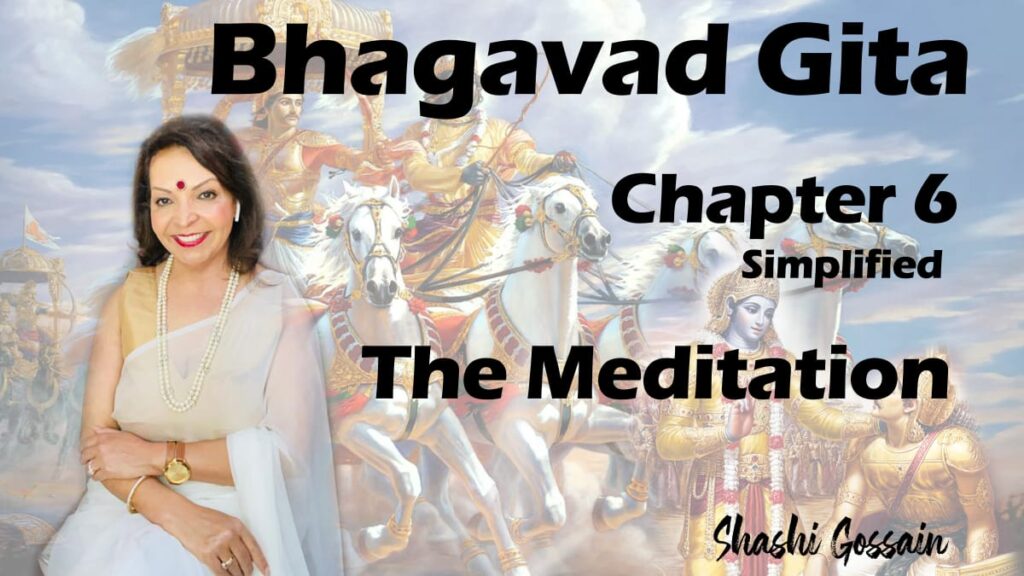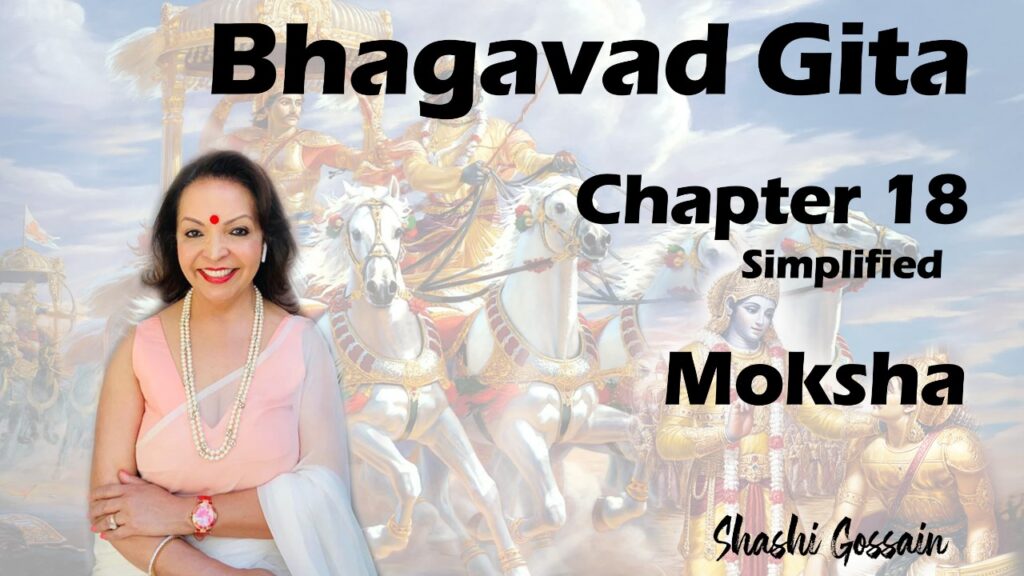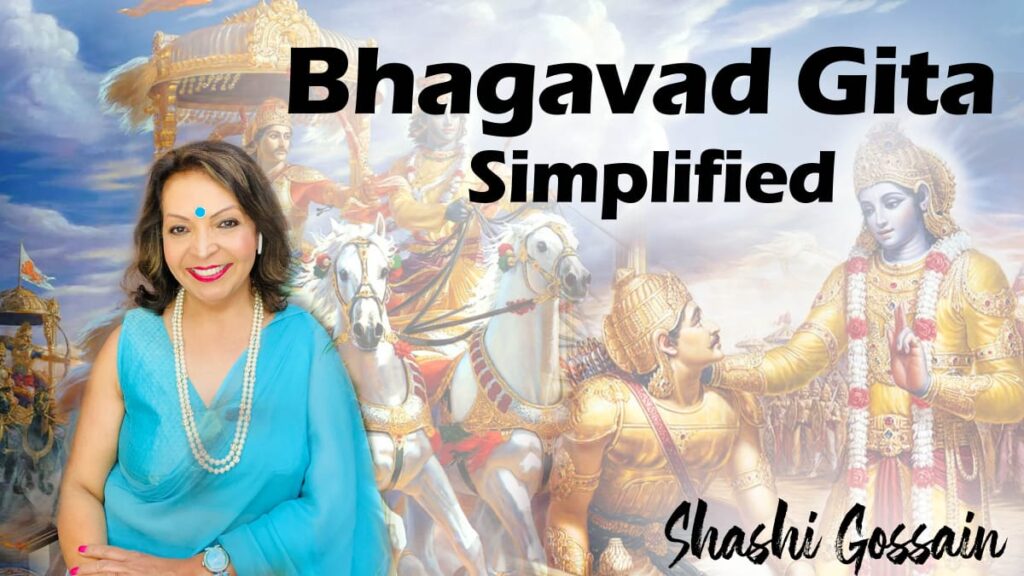In chapter 5, Shri Krishna goes into detail about the principles of karmayoga and renunciation of desires. But before we can practice yoga properly, one must master the practice of meditation. This chapter is about Meditation.
In chapter 6, Shri Krishna becomes very specific, explaining-
- What is meditation?
- What is the process?
- How do you meditate?
- Who is qualified to become a meditator?
He begins by redefining what is meant by a sanyasi (monk) or dhyaana yogi (meditator).
What does meditator mean?
A meditator is not one who has given up his duties or actions or has run away from the world. As long as our desires exist, they will continue making us restless and agitated. So the karmayogi intelligently channels these desires to a higher ideal, so that the results lose their power to create further selfish desires. They become detached from the result of the desire. As our attachment to results drops, the mental restlessness and agitations will diminish, making us fit to pursue meditation. Firstly, Krishanaji describes the person
who can meditate:
In the olden days, householders would maintain a sacrificial fire in their homes. The absence of the fire indicated renouncing the duties of a householder. Krishnaji says, that in order to meditate one does not have to renounce fire; one does not have to physically renounce action and retire to a monastery. To advance to a meditator, one has to attain karmayoga that means the loss of sense of do-ership.
What is a sage as a person?
A sage is one who has realized through daily life experiences, that worldly goods or relationships are not going to give any joy, and wishes to ascend to a higher plane. They may be in two different levels of maturity:
- If his mind still has desires, then the only path is Karmayoga, to develop discrimination (viveka) and dispassion (vairagya)
- If his mind does not harbour desires, and does the bare minimum activities, as is absolutely necessary, he is ready for meditation.
If we want to go down the spiritual path, we have to lift ourselves by our own efforts. Our success and failure are entirely in our hands. No other person can help or hurt us. One who is unable to conquer his mind and senses becomes his own enemy. We have to repeatedly train our minds to go in the right direction & not be brought down by temporary sensory temptations. Over a period of time, we can control our minds. So this person is not ready for meditation.
What are the qualities of a sage?
Krishnaji then describes the actions of the person who has realized the eternal essence through meditation.
- Towards situations: his mind is calm & peaceful (prashaantaha), because he knows that any situation can only impact the body, mind & not the self.
- Towards objects: he is content with knowledge & mastery over senses. To him, a stone or gold is the same. They fail to attract him and does not give them undue importance. This person is yuktaha, or completely established in meditation.
- Towards people: he views friends & enemies alike. He is indifferent towards all. He is called “udaaseena”, meaning lifted himself higher.
To get to this level, the thinking has to change. The meditator begins to view the workings of the world as Ishvara’s plan by submitting all actions to Ishvara, regardless of whether he encounters a good or bad situation, person or object. According to Geeta,
How do you meditate?
Krishnaji shows us the preparation, bearing in mind that the main goal of meditation is to absorb our mind into our self or aatmaa.
- Find a quiet spot, with no distractions, so as to quieten the mind. All thoughts of past & future must be dropped. It’s not a group activity & no external aids are needed.
- The seat must be clean and pure, stable, and not too high or low. This frees us from distractions e.g. is an insect on the floor? are we going to lose balance?
- Put a cloth or a mat on the seat to keep a layer of insulation. A hot or cold seat would be a distraction. The mind has to be controlled by focusing on a point on the wall or the tip of the nose. Meditation helps one to achieve the last step, which is the internalization of this knowledge (nidhidhyaasa).
Why is posture important in meditation?
Shri Krishna then describes the perfect posture of meditation. The body has to be kept firm & steady, where the trunk, head & neck are perfectly aligned. Then the mind has to be controlled by focusing on the tip of the nose & control of breath. Once we have made all the physical preparations and are ready to begin meditation, the question comes up: what do we meditate upon? Shri Krishna has a simple answer. He says, meditates upon me. He asks us for two things:
- To focus our mind on him
- Regard him as the highest goal to be attained.
For beginning seekers, the notion of meditating upon the abstract aatmaa or self is difficult. To that end, he asks the seeker to choose any one form of higher ideal or Deity (otherwise one would start concentrating on food or events or internal fears.)
What happens in samadhi?
A balanced and moderate lifestyle is needed towards achieving our spiritual goals. Shri Krishna says that meditation will not be easy for one who constantly deprives his body of food and sleep, or for those who over-eat or over-sleep. Well-regulated diets, exercise, conduct, and sleep is essential to become a meditator. Meditation is not a mechanical activity; it needs uncompromising support from the body, mind, and intellect. He compares the mind of a meditator to the flame of a lamp that is burning in a windless room. Just like the flame is unwavering due to the absence of wind, so too is the mind of a meditator steady due to the absence of desire. The culmination of meditation is when our focus and concentration reach their peak, and the target of meditation becomes our own aatmaa. This is the state of samaadhi. He says that this joy is infinite and is comprehended only by the intellect.
What are 3 benefits of meditation?
Meditation aims at removing 3 defects of our personality:
- mala: causes the mind to rush out & the urge to act to external smells or sounds
- vikshepa: tendency of mind to get distracted with thoughts
- aavarana: covering of our minds, which prevents us from fully getting established in the knowledge of the eternal essence.
Meditation gives an inner strength that can protect us from jolts in life. We become like a rock that remains steady in a storm, not the tree that gets uprooted. whenever we encounter an obstacle that pushes us off the path of meditation, we get up and continue, again and again, by continually checking unwanted thoughts with a firm determination to attain the state of the perfected meditator. Intellect uses thought processes instead of impulse e.g. if you need to take bitter medicine to cure a disease, your intellect will compel you to take it, instead of listening to the tongue taste. Similarly, all thoughts that cross the mind, have to be evaluated by the intellect before any actions are taken. This training may take months or even years, but one has to be disciplined and persevere. The constant practice of removing stray thoughts is called “abhyaasa”. Krishnaji actually turns this around and says that Joy is attracted to a serene, calm mind. It’s the meditator that is sought after by joy. Krishnaji says that the perfected meditator “sees himself in all beings”, or one with “equal vision”, which comes out of wisdom. This vision is sometimes called the “third eye”. Shri Krishna now speaks to us directly as Ishvara. He says that the devotee, who sees him in everything, and everything in him, will have a permanent connection to him, (Shri Krishna). Shri Krishna, in the Gita, is telling us that he is everywhere. He’s not in the obscure clouds in heaven. Shri Krishna fully knows that for most of us on our spiritual journey, it will take a long time for our intellects to see the eternal essence everywhere. To make it easier, we should try to see everything in Ishvara and Ishvara in everything. Ishvara could be the form of Shri Krishna or any other deity that we feel an affinity towards. That is why in Hinduism, everything can become an object of worship, from a tree to a stone to a book, because Ishvara is present in everything. Shri Krishna says that the yogi never loses this oneness; it stays with him no matter where he is or what he is doing. The yogi does not need to go on a pilgrimage or visit any specific temple, because he is always connected to Ishvara. This yogi will never hurt anyone else physically, mentally, or verbally. This vision reaches its peak when we do not perceive any difference between ourselves and the world. Everything is one and the same.
Questions of Arjun
Although Arjuna had been listening attentively to Shri Krishna’s discourse, he still had questions.
- How can we remain established in the meditative state, when the mind is so fickle & rebellious?
Shri Krishna then said that the mind, though hard to restrain, can be controlled through constant discipline and dispassion. It is the technique of constant hearing, contemplation, and internalization of knowledge, with a complete analysis of all our thoughts at every moment. - What happens when a seeker is striving to meditate faithfully and diligently but is unable to reach the state of the perfected meditator in his lifetime?
Arjun thinks that would have been wasted time, where he could have very easily obtained more wealth & status. Shri Krishna points out that, one who takes up meditation sincerely will automatically develop dispassion towards wealth, power, and fame. He will not care whether he attains material success or not. So, therefore, a lack of material success will not cause him distress. Shri Krishna continues to answer Arjuna’s question with regards to what happens to the unfulfilled meditator after death. He says The Law of Nature will ensure that he will be taken care of even after death. Such a meditator attains heaven, and having stayed there for a long period of time, he is born into a family that is conducive for continuing his spiritual journey. e.g a family of yogis.
What are 2 types of meditators?
Shri Krishna had explained the fate of two types of meditators. He said,
- The ones that harbour desires will be born into a wealthy family.
- The ones that have no desires are born into a family of accomplished meditators or yogis. He now says that the ones that are born into the yogic family reconnect with their intellect from their prior birth. In other words, their effort in their previous life does not go to waste. We see examples of child prodigies, especially in the field of music and science, who achieve expertise in their fields within a few years of being born. Their personality is somehow pre-configured to excel in their chosen field. Such prodigies get the benefit of nature, (which is their parents’ genes), and nurture, Similarly, those who are born into a family of meditators get the benefit of nature and nurture. They will continue their spiritual journey and begin to strive for liberation automatically. Moreover, their determination will be much stronger than their prior attempt. Other people will find it bewildering that these children do not get attracted by things that most children crave. The unfulfilled meditator who is born into a prosperous family. His previous efforts will push him towards rekindling his spiritual journey. This attraction or push towards spirituality will give him the potential of transcending his material pleasures. Shree Krishna urges all spiritual seekers to continuously strive towards attaining their spiritual goals, no matter what their history is. It may take many lifetimes to purify his sins, before ultimately attaining the state of liberation. Arjuna is born into one of the most illustrious families of his time. But through the knowledge that he is receiving from Shri Krishna, he has the option of pursuing the spiritual path, but only if he incorporates this teaching into his life. Having described the:
- ● need for meditation
- ● definition of meditation
- ● process of meditation
- ● fate of a meditator
He now positions meditation as the ultimate means of attaining liberation.
There are three types of spiritual seekers:
- The taspasvi who practices austerities in the form of minimizing exposure to the material world, such as fasting, donating wealth
- The karmayogi who detaches from desires
- The jnyaani who studies scriptures & spiritual knowledge.
He says that the yogi,(the meditator), is superior to people who practice austerities, work selflessly or study the scriptures. Meditation is the only means of liberation. That is why he urges Arjuna to follow the path of meditation, as the conclusion of his spiritual practice. Like Arjuna, most of us have worldly duties and responsibilities. Till we reach a stage in life when meditation becomes our whole being, what do we do to continue our spiritual journey? How do we stay connected to the eternal essence when we are not meditating? Shri Krishna says that we should develop the highest possible ideal to whom we can dedicate all our worldly actions, and that is to worship to the eternal essence in its universal form, which is nothing but God or a deity. Therefore, the concluding message of this chapter to Arjuna, and to us, is to develop devotion. Devotion will ensure that we remain connected to Ishvara. In order to do so, we first need to understand who is Ishvara, where is He located? How can we access him? Only then can we truly develop devotion. This is the topic of the next six chapters, which is bhakti or devotion.



